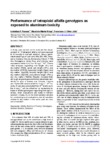Please use this identifier to cite or link to this item:
http://www.alice.cnptia.embrapa.br/alice/handle/doc/921804| Title: | Performance of tetraploid alfalfa genotypes as exposed to aluminum toxicity. |
| Authors: | PASSOS, L. P.  KOPP, M. M.   LEDO, F. J. da S.   |
| Affiliation: | LEONIDAS PAIXAO PASSOS, CNPGL; MAURICIO MARINI KOPP, CPPSUL; FRANCISCO JOSE DA SILVA LEDO, CNPGL. |
| Date Issued: | 2012 |
| Citation: | Agricultural Sciences, v. 3, n. 2, p. 230-240, 2012. |
| Description: | A study was carried out to evaluate the development of 12 tetraploid alfalfa cultivars exposed to Al toxicity in nutrient solution. Newly germinated seedlings of cultivars Alfa 200, Alto, Araucana, Costera, Crioula, Esmeralda, Falcon, F-708, Rio, Romagnola, Valley Plus, and Victoria, were exposed to either 0, 4, 8 or 12 mg·L-1 Al3+. Plants were analyzed regarding root length (RL) and dry matter (RDM), aerial part length (APL), and dry matter (APDM), hypocotyl length (HypL) and dry matter (HypDM), epicotyl length (EpiL) and dry matter (EpiDM), and petiole length (PetL), and dry matter (PetDM). Results indicated that, although all genotypes exhibited detectable sensitivity to such a stress, cvs. Crioula, Victoria and Alpha-200 were tolerant to 4 mg·L-1 Al3+ toxicity. It was also concluded that Al3+ levels up to the 4 mg·L-1 will be effective for screening tetraploid alfalfa genotypes regarding this type of stress, when evaluations are made in nutrient solution. Finally, RL is the most suitable variable for conducting such evaluations, but all variables related to dry matter in the aerial part are also recommended. |
| NAL Thesaurus: | alfalfa |
| Keywords: | Aluminum toxicity Genotypes Nutrient solution Selection |
| DOI: | http://dx.doi.org/10.4236/as.2012.32027 |
| Type of Material: | Artigo de periódico |
| Access: | openAccess |
| Appears in Collections: | Artigo em periódico indexado (CNPGL)  |
Files in This Item:
| File | Description | Size | Format | |
|---|---|---|---|---|
| 2012Alum.AlfafaPassosAS2012020001124121375.pdf | 2,17 MB | Adobe PDF |  View/Open |









